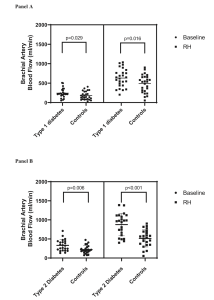Background and aims: Chronic hyperglycemia and hyperinsulinemia affects the synthesis and release of vasoactive substances from the endothelium, including nitric oxide, endothelins, and prostacyclin, which normally play a crucial role in regulating regional blood flow (BF). Microvascular function plays a crucial role in regulating BF in peripheral tissues based on metabolic demand. The study aimed to evaluate BF and microvascular function in the forearm of people with type1 and type 2 diabetes at rest and after ischemia. Methods: People with diabetes and sex-matched healthy controls were recruited. Brachial artery diameter and blood velocity were continuously measured at rest and after ischemia by an automatic tracking system. BF and vascular conductance were then calculated. Stroke volume, cardiac index (CI) and systemic vascular resistance (SVR) were also measured by trans-thoracic echocardiography. Results: Forty-nine people with diabetes and 49 controls were enrolled. BF at rest and after ischemia was significantly higher in people with diabetes than controls: Type 1, 243 ±116 and 631 ±233 ml/min; controls, 180 ±106 and 486 ±227 ml/min; Type 2, 332 ±149 and 875 ±293 ml/min; controls 222 ±106 and 514±224 ml/min (Fig.). Vascular conductance was significantly higher in Type 2 than in controls at rest and after ischemia. CI was significantly higher in diabetes than control (Type 1 vs control: 2.5±0.6 vs 2.2±0.6 l/min/m2; Type 2 vs control: 2.5±0.6 vs 2.1±0.5 l/min/m2), along with a reduction of SVR, but only in Type 2 diabetes. Conclusions: People with diabetes exhibited significantly increased BF, with Type 2 also showing heightened vascular conductance. Activating metabolic pathways triggered by hyperglycemia may lead to distinct vascular redistribution, potentially impairing blood flow over time. These findings of the study underscore the importance of understanding overall vascular dynamics in diabetes and its implications for vascular health.


